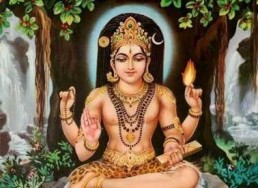Om Namo Bhagavate Dakshinamurthaye
मह्यं मेधां प्रज्ञां प्रयच्छ स्वाहा ॥
mahyaṃ medhāṃ prajñāṃ prayaccha svāhā ..

Description
Amürtih is the one who is formless and who is the truth of everything. With maya-sakti Isvara is daksinah, the one who has the capacity to be the creator and sustainer, and also the one who can take back the whole creation into himself. Therefore, Isvara who is daksina as well as amürti is Daksinamürti.
Daksina also means the southern direction. He is the Lord who is facing the south, daksinn-dik-abhi-mukha murtih. What is the significance of the southern direction? The north attracts, and it stands for moksha. The south stands for samsara; it is Lord Yama’s place. The Lord is everywhere, but the one who wants release from samsara faces the Lord in the north. The Lord has to face you to teach. As the source of all-knowledge, he faces the south. Salutations unto Lord Daksinamürti who is the source of all-knowledge and the source of all blessing.
Mahyam, to me, prayaccha, give; what? Asking is important. Always ask for what do you want. Often we hear, “Do not ask Bhagavan. He knows everything. He knows what do you need.” Asking is part of prayers, as a karma. Bhagavan’s grace is always available, but you have to tap it. This grace is like ground water that has to be tapped by the act of prayer. Gaining anything in terms of worldly or spiritual life depends upon your making the right decisions. Life is a series of decisions. You are what you are because of your decisions. For making the right decisions you require two things, prajña, clarity of knowledge and medha, availability of memory. In understanding any topic, you require prajña. It means alertness, clarity of vision. No matter what the topic is, whether it is a moral issue, a legal issue, or an economic issue, to succeed you require prajna.
Medha, thinking power and memory has to be at service always. Memory is important. If medha and prajna are there, all success will come to you. That is why you pray, “Oh Lord please bless with me with medha and prajna.”
Svaha is a word used at the time of offering oblations unto fire for different devatas. Here the meaning would be, “This chanting is my offering to you.”
Excerpt from the book “Prayer Guide” by Swami Dayananda
Other Dakshinamurthy Shlokams
Dakshinamurthy Stotram
Shlokams,Sankara,Shiva,Dakshinamurthy
The Dakshinamurti Stotra is a Sanskrit religious hymn to Shiva by Sri Adi Shankaracharya. It explains the metaphysics of the universe in the frame of the tradition of Advaita V
Ishvaro Guru Atmeti
Shlokams,Shiva,Dakshinamurthy,Guru,Sankara
Salutations to Lord Dakshinamurti, who is all-pervasive like space but who appears (as though) divided as Lord, Guru, and the Self.
Mauna Vyakhya
Shlokams,Sankara,Shiva,Dakshinamurthy
I salute Sri Dakshinamurti, who is not subject to time, who makes known the truth of Brahman through the implied meaning of words, who is surrounded by disciples who are themselves Rishis and committe
Nidhaye Sarvavidyanam
Shlokams,Sankara,Shiva,Dakshinamurthy
Salutations to Sri Dakshinamurti, the reservoir of knowledge (the abode of all learning), the healer of all those who suffer from the disease of samsāra, and the teacher of the whole world.
Om Namah Pranavarthaya
Shlokams,Sankara,Shiva,Dakshinamurthy
Om. Salutation to the one who is the meaning of praņava, who is in the form of pure knowledge, who is taintless and who is free from any change. To that Sri Dakshinamurti, (my) salutations.
Om Namo Bhagavate Dakshinamurthaye – Dakshinamurthy – In Sanskrit, English Translation, Meaning, Significance and Audio. With commentary by Swami Dayananda

